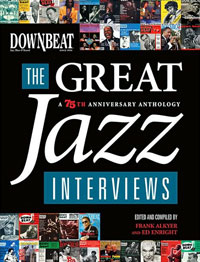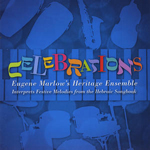Home » Jazz Articles » Book Review » DownBeat: The Great Jazz Interviews - A 75th Anniversary Anthology
DownBeat: The Great Jazz Interviews - A 75th Anniversary Anthology
 DownBeat: The Great Jazz Interviews: A 75th Anniversary Anthology
DownBeat: The Great Jazz Interviews: A 75th Anniversary AnthologyFrank Alkyer and Ed Enright, Editors
Softcover; 352 pages
ISBN: 9781423463849
Hal Leonard
2009
In a 1988 interview, trombonist J.J. Johnson declared: "Jazz is restless. It won't stay put and it never will." There's no better proof than this remarkable anthology from DownBeat magazine, which contains 124 interviews or artist-written articles covering seven decades of jazz history.
The interviews are full of delicious insights into jazz and jazz musicians. Open any page, and you're bound to find something inspiring and intelligent. In a 1949 interview, the alto sax master Charlie Parker stated: "They teach you there's a boundary line to music, but, man, there's no boundary line to art." In 1966, cornetist Rex Stewart asserted that pianist Art Tatum's ear was so precise, he "could tell the key of any sound, including a flushing toilet." Talking about piano great Fats Waller, saxophonist Ben Webster observed, "All that fun but never a wrong note." In 1958, saxophonist John Coltrane said: "When I first heard Bird, I wanted to be identified with him...to be consumed by him. But underneath I really wanted to be myself." And sometimes the book is just plain fun, as when it quotes the always charming Louis Armstrong: "I am so happy, at the age of 50, still blowing my little Satchmo trumpet, still enjoying the fine things in life, still love everybody, and everybody still loves me."
As the book unfolds, it's fascinating to witness how jazz styles develop, cause controversy, gain acceptance, and then become a barrier for the next generation to break through. No matter the decade, there's a constant redefinition of what jazz is, not just by critics but by the musicians themselves, whether it's clarinetist Benny Goodman in 1954 lamenting jazz's decline as America's popular music, pianist Herbie Hancock stating in 1971 that "Jazz is not dead," or the Jazz at Lincoln Center Orchestra on tour playing Duke Ellington's music in the year 2000, on a mission to revive a traditional art form. It's an education in impermanence, as well as in what endures.
One of the themes throughout the book is how to negotiate artistic endeavor and commercial success. There are many sides to the struggle, whether it's clarinetist Artie Shaw's ongoing love/hate relationship with the business, trumpeter Freddie Hubbard boldly declaring in 1981, "I wanna live good," or the Art Ensemble Of Chicago struggling in the 1970s to feed their families and keep their music alive without compromise. And then there's Quincy Jones, for whom there is no issue. As Jones said in 1985: "The whole menu. Why not, man?" Artists of all stripes can learn a great deal by seeing how some of the great artists of our time have dealt with—and still deal with—this issue.
The book also provides an education on the art of conducting an interview. Is it preferable for the interviewer to insert themselves, or to step back and let the other speak? How do you handle a recalcitrant interview subject, and how do you keep things fresh with a musician or group who has already done a dozen interviews that week? Lee Underwood's 1980 interview with trumpeter Maynard Ferguson is particularly entertaining. Ferguson cheerfully avoids Underwood's pointed questions, leading the interviewer and the reader on a merry chase. And Art Lange's 1984 interview with pianist Keith Jarrett is a model of discipline. Lange easily keeps up with Jarrett's formidable knowledge of classical music, and provides an example of how an interviewer can encourage their subject's ideas. As the book unfolds, it's sheer pleasure to experience the artistry of top-notch journalists such as Nat Hentoff, Studs Terkel, Ira Gitler, Leonard Feather—the list goes on and on.
The cliché "No jazz library would be complete without this book" is no cliché here; short of owning every single issue of DownBeat, this book represents the most concise way to gain access to the magazine's gold. Each interview has its bright points and is a world unto itself, but the cumulative effect is a celebration. This book is another reminder of the rich history of jazz—full of great talents, intelligence and personalities, people who have brought tremendous beauty into the world, and continue to do so.
Tags
Book Reviews
Florence Wetzel
United States
J.J. Johnson
Charlie Parker
Rex Stewart
Art Tatum
Fats Waller
ben webster
John Coltrane
Louis Armstrong
Benny Goodman
Herbie Hancock
duke ellington
Artie Shaw
Freddie Hubbard
Art Ensemble of Chicago
Quincy Jones
Maynard Ferguson
Keith Jarrett
PREVIOUS / NEXT
Support All About Jazz
 All About Jazz has been a pillar of jazz since 1995, championing it as an art form and, more importantly, supporting the musicians who make it. Our enduring commitment has made "AAJ" one of the most culturally important websites of its kind, read by hundreds of thousands of fans, musicians and industry figures every month.
All About Jazz has been a pillar of jazz since 1995, championing it as an art form and, more importantly, supporting the musicians who make it. Our enduring commitment has made "AAJ" one of the most culturally important websites of its kind, read by hundreds of thousands of fans, musicians and industry figures every month.























